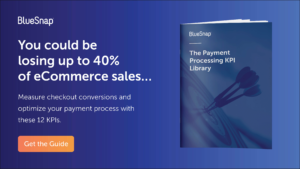If measuring the performance of your payment system isn’t a regular part of your business assessment process, it should be. Here’s why: Up to 40% of your online sales are currently being lost due to shortcomings on the part of your payment gateway and/or because of friction in the checkout process. If you’re not paying attention to this crucial aspect of your business, you’re letting money slip through your fingers—and customers slip through the cracks.
The only way to be sure your payment system is functioning optimally (and protecting your hard-won sales) is by using payment metrics. Payment metrics help measure various aspects of your payment process, giving you valuable data on two important things:
- Specific business policies that may need improvement. Using the data you gather, you can analyze problem areas and root causes, implement fixes, and review changes after the fact to see how well those changes worked.
- How well your payment gateway provider is performing. Primarily, you need to know if your payment provider is giving you the tools to deliver checkout excellence. If they don’t have a fix for the problem areas you’ve identified, then they’re only contributing to the loss of sales—a clear sign that you need to make a change.
But even if you’re ready to start using payment metrics, how do you know what, exactly, to measure? Key performance indicators (KPIs) that measure different aspects of your payment system—payment conversions, successful transactions, fraud, and more—will give you actionable data you can use to make targeted changes. Your conversion rate is perhaps the most critical payment metric. Below are a few payment conversion KPIs to get you heading in the right direction.
3 Key Payment Conversion KPIs
Here are three KPIs to measure payment conversions:
1. Payment Conversion Rate
This straightforward metric tells you how many transactions on the whole were declined. If 80 out of 100 transactions were successful, you have an 80% payment conversion rate. There are many reasons why transactions are declined—incorrect card information, insufficient funds, invalid card numbers, suspicion of fraud, etc.—so the more detail your provider can give about the reasons behind declined transactions, the better. For example, if an unusually high number of transactions are declined due to possible fraud, your payment provider should be working harder behind the scenes to prevent this from happening. The issues that come to the forefront are the ones you should focus on addressing.
2. Conversion Rate By Bank
If multiple declines are associated with a specific bank, the bank may have recently adjusted its fraud rules, which, in turn, is impacting your sales. You can resolve this situation, but you’ll need more information about the declined transactions in order to do so, including the bank name and bank identification number (BIN) on the shopper’s credit card. Your provider should be able to provide reporting that shows you your conversion rates by issuing bank and BIN so you can easily identify problems.

3. Conversion Rate By Payment Method And Card Type
Even though it’s hard to know for sure if payment methods are the reason for declined transactions, knowing the conversion rate by payment method and/or card type will still give you some helpful data. It’s a good practice to track the performance of newly added payment methods—the addition of eWallets, for instance—for comparison to your existing offerings to stay on top of customer preferences and payment trends. It’s also useful if you’re considering redesigning your checkout page to make your highest-performing payment types more prominent. In that case, the data you gather can be used to maximize your conversions.
Want more payment processing KPIs?
To get the most out of payment metrics, you should be measuring more than just payment conversions. Other areas of your payment process can be just as revealing when it comes to identifying opportunities for improvement.
If you’d like to get more information about payment metrics, as well as nine additional insightful payment processing KPIs related to fraud, transaction success rate, and more, download our Payment Processing KPI Library for free. It includes all the key metrics you need to continually improve your checkout experience and convert and protect more revenue. Do more to encourage transaction success for your business—download the KPI Library, and get started measuring today!
Related Resources:
- Time for a New Payment Processor? [Quiz]
- The Better Way to Accept Payments Globally: 3 Questions to Ask About Your Global Online Payment Processing Solution
- 5 Critical eCommerce KPIs You’re Missing In Your Payment Reports
Frequently Asked Questions
Do you offer any reports to help me manage my business?
Yes. Our platform is set up with reports to help you build and manage your business, whether you need clarity on your conversion rates or insight into your sales and revenue. All of your sales and shopper records are permanent so you can consistently and accurately track them and plan accordingly. Refer to key reporting & analytics tools.
How do digital payments work?
Whether for B2B card processing or B2C card transactions, digital payments work the same:
- The gateway captures the transaction request and either encrypts or tokenizes the information, then routes it to an acquiring bank.
- The acquiring bank (which provides your merchant account) takes ownership of the transaction request. Its job is to get authorization for the transaction.
- The issuing bank assesses the request: Does the customer have sufficient credit or funds? The issuing bank generates a response — yes or no — and sends it back to the acquiring bank via the card network.
- The acquiring bank sends the response back to the payment gateway.
- The payment gateway’s final job is to present the answer either back to the merchant or to the shopper directly (if you’re using a hosted payment page).
Congratulations, your order is approved!
Which payment methods are available to my customers?
We offer over 100 currencies and over 100 payment types. Credit cards, mobile wallets, PayPal, e-Check/ACH, local bank transfer, and SEPA Direct Debit are just a few of the many payment types BlueSnap supports.
What is BlueSnap?
BlueSnap helps businesses accept global payments a better way. Our All-in-One Payment Orchestration Platform is designed to increase sales and reduce costs for all businesses accepting payments.
BlueSnap supports payments across all geographies through multiple sales channels such as online and mobile sales, marketplaces, subscriptions, invoice payments and manual orders through a virtual terminal.
And for businesses looking for embedded payments, we offer white-labeled payments for platforms with automated underwriting and onboarding that supports marketplaces and split payments.
With one integration and contract, businesses can sell in over 200 geographies with access to local acquiring in 45+ countries, 110+ currencies and 100+ global payment types, including popular eWallets, automated accounts receivable, world-class fraud protection and chargeback management, built-in solutions for regulation and tax compliance, and unified global reporting to help businesses grow.


